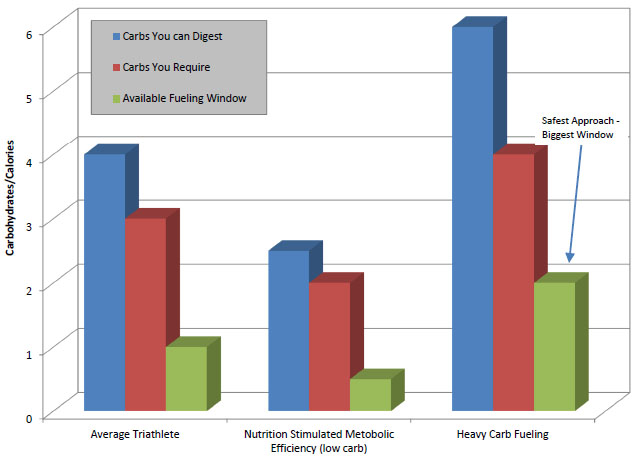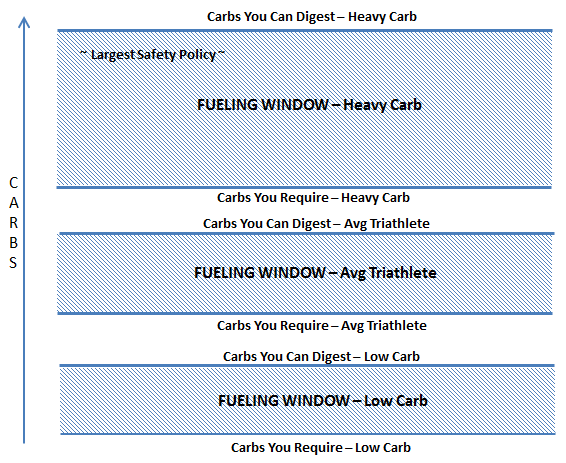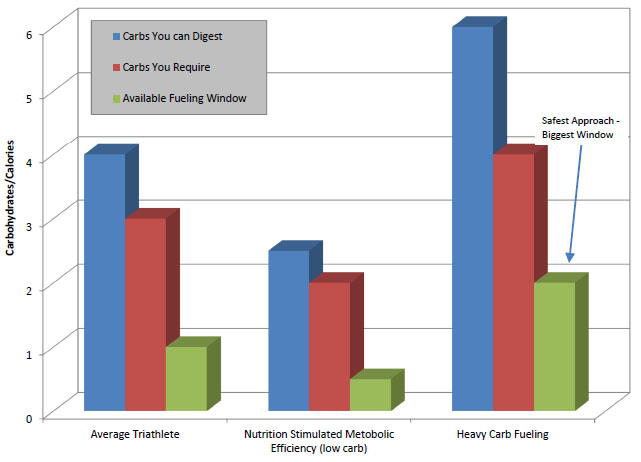I continue to get asked by athletes and coaches about taking a lower carbohydrate approach to fueling long course events. This concept sounds great on the surface, like Total Immersion-style swimming in triathlon, but as you dig deeper, you discover its pitfalls. I’ll sum this concept up as “Metabolic Efficiency Training – By Nutrition Modification” (low carb approach). I add the nutrition modification piece, as training via proper intensity ranges provides “Metabolic Efficiency” without tinkering with nutrition and is a proven concept. In my mind, there are two major components to the low carb approach: training nutrition modification/impacts and race day modification/impact. The first I discussed in pretty good detail here as“Starvation Workouts”– and the second I’ll discuss in more detail here. I’ll preface this discussion with the experience QT2 has with race fueling. Each year we do about 300-400 detailed race fueling plans for athletes from around the world of all levels. We’ve been doing this for about seven years. I have personally done fueling plans for over 40 PROs (many of whom I don’t coach).
The bottom-line is we do a LOT of race fueling plans, see a lot of sweat rates, and most importantly see just about every issue you could possibly imagine come through the door. I would bet that we do more triathlon-specific race fueling plans than any other group in the world. We get the chance to collect a lot of data, and our team works together throughout the year to discuss issues, and experiences. At the end of the year, we can typically count on one hand how many athletes have issues with their nutrition, after working with us. That is an approximately 99% success rate. You get the picture. Below are the major factors related to this discussion and the low carb approach in general.
Training Your Body To Use Less
The low carb approach may train your body to use less over time, which again sounds great – less fuel to carry around all the time, less food to digest on race day, and less money to spend on race fueling. You hear this all the time – the athletes who get to the point where they can ride for 5 hours with only a single Powerbar; amazing accomplishment! Obviously a higher carb in training won’t allow you to develop this efficiency…..but is that a bad thing? I discussed the primary risks in this scenario in“Starvation Workouts”.
Potential Benefits
The potential benefits of training your body to use less are touted as improvements to fat utilization, and therefore performance. I will state that the research I have seen here is very skeptical. Proven benefits of nutrition induced fat utilization are shaky at best, and even if they do exist are on the order of 1% impact on performance in my opinion. Is 1% worth the risks discussed inStarvation Workoutsand what I am about to describe below?
Training Your Body To Handle Less
The MAJOR issue associated with the low carb approach for race day is that over time you are not only training your body to use less, but also training it’s digestive system to handle less; typically the latter at a faster rate. This is the major danger for most athletes racing long course – the primary limiter for many, many age groupers is their ability to handle their race nutrition; whatever it may be. Its not about gaining that 1 percent advantage in metobolic efficiency. I consider this a parallel limiter, enhancing performance maybe, whereas the ability to handle nutrition is a series limiter, meaning it can stop you from hitting other limiters such as fitness itself (which you train and make huge sacrifices for). Anything we can do to remove this as a limiter will only help.
The Fueling Window
Below are two figures summering and visually displaying the concept I call “The Fueling Window” which describes what I have discussed above. These figures are based on my experience and not necessarily to scale. This concept is a pseudo-science based on real-world results with thousands of athletes – not a clinical lab study with limited inputs, and limited real-world results.


What this shows is that with a low carb approach, yes, you may improve metabolic efficiency and reduce the amount of fuel your body requires, but it comes at a significant cost! You also reduce your ability to digest and handle nutrition. Overall, you reduce your available “fueling window” (difference between what your body needs and what your digestive system can handle) and likelihood of success.
We’ve proven this concept year after year with some of the fastest run splits across the age group, and PRO levels, including multiple athletes running sub 3:00 and over 27 Kona qualifiers last year. Our athletes have trained themselves to hit the run better fueled than almost all other athletes on the course…..this is the “secret” to how we do it. This is one of our most important concepts used to get results. The primary issue that athletes have with the higher carb approach, if they have any, is that they don’t practice it seriously enough. This would be like doing an Ironman without training at all, and then after DNFing the race saying, Ironman isn’t for me. To be done right, fueling needs to be practiced day in and day out, every single session from 30 minute recovery runs to 6 hour rides – EVERY SINGLE TIME! If it’s a warmer weather race, and you are a heavy sweater, you should likely be drinking 3 to 4 24oz bottles of Powerbar Perform every hour in training. Yes, this is overdoing it, but it takes nutrition off the table as a limiter on race day – you’ve trained yourself to handle more than your body requires, thereby improving your “fueling window”. I can honestly say that I have never seen an athlete who practices their fueling properly have lingering issues on race day. Some need to practice harder and longer than others.
I will say that there is a small percentage of the population that has gotten away with the lower carb approach, even though it is risky. In these cases the athlete typically was born with a fantastic digestive system that can handle a lot of fluid/carbs, and has lower sweat rates. Even at that, it’s a risk they take. By, and large, the primary limiter of age groupers in long course racing is the ability to handle nutrition…we want to practice the ability to digest more, not try and obtain a 1% advantage and instead end up walking the run because our “fueling window” is so small that, we can’t even digest the smallest amount. This is simply not a risk worth taking for 99.9% of the athletes racing long course. This practice in short course racing may have more relevance, because the ability to handle large amounts of nutrition becomes less of a factor, it’s harder to get down nutrition at intensity, and therefore the metabolic efficiency risk may be one worth taking.
~ Jesse















Comments